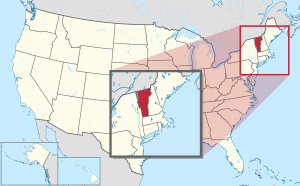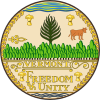
Back Vermont Afrikaans ቬርሞንት Amharic Vermont AN Fermunt ANG فيرمونت Arabic ܒܝܪܡܘܢܬ ARC ڤيرمونت ARY ڤيرمونت ARZ Vermont AST Vermont suyu Aymara
Vermont | |
|---|---|
| Nickname: The Green Mountain State | |
| Motto(s): Freedom and Unity and Stella quarta decima fulgeat (May the fourteenth star shine bright) | |
| Anthem: These Green Mountains | |
 Map of the United States with Vermont highlighted | |
| Country | United States |
| Before statehood | Vermont Republic |
| Admitted to the Union | March 4, 1791 (14th) |
| Capital | Montpelier |
| Largest city | Burlington |
| Largest county or equivalent | Chittenden |
| Largest metro and urban areas | Burlington |
| Government | |
| • Governor | Phil Scott (R) |
| • Lieutenant Governor | David Zuckerman (P) |
| Legislature | General Assembly |
| • Upper house | Senate |
| • Lower house | House of Representatives |
| Judiciary | Vermont Supreme Court |
| U.S. senators | Bernie Sanders (I) Peter Welch (D) |
| U.S. House delegation | Becca Balint (D) (list) |
| Area | |
| • Total | 9,616 sq mi (24,923 km2) |
| • Land | 9,250 sq mi (23,957 km2) |
| • Water | 382 sq mi (989 km2) 4.1% |
| • Rank | 45th |
| Dimensions | |
| • Length | 160 mi (260 km) |
| • Width | 80 mi (130 km) |
| Elevation | 1,000 ft (300 m) |
| Highest elevation | 4,395 ft (1,340 m) |
| Lowest elevation | 95 ft (29 m) |
| Population (2023) | |
| • Total | |
| • Rank | 49th |
| • Density | 70/sq mi (27/km2) |
| • Rank | 31st |
| • Median household income | |
| • Income rank | 16th |
| Demonym | Vermonter |
| Language | |
| • Official language | None |
| • Spoken language | |
| Time zone | UTC–05:00 (Eastern) |
| • Summer (DST) | UTC–04:00 (EDT) |
| USPS abbreviation | VT |
| ISO 3166 code | US-VT |
| Traditional abbreviation | Vt. |
| Latitude | 42°44′ N to 45°1′ N |
| Longitude | 71°28′ W to 73°26′ W |
| Website | vermont |
| List of state symbols | |
|---|---|
 | |
| Living insignia | |
| Amphibian | Northern leopard frog Rana pipiens |
| Bird | Hermit thrush Catharus guttatus |
| Fish | Brook trout Salvelinus fontinalis Walleye Sander vitreous vitreous |
| Flower | Red clover Trifolium pratense |
| Insect | Western honey bee Apis mellifera |
| Mammal | Morgan horse |
| Mushroom | Bear's head tooth mushroom Hericium americanum |
| Reptile | Painted turtle |
| Tree | Sugar maple Acer saccharum |
| Inanimate insignia | |
| Beverage | Milk |
| Food | Apple pie |
| Fossil | Woolly mammoth, beluga whale[5] |
| Gemstone | Grossular garnet |
| Mineral | Talc |
| Rock | Granite, marble, slate |
| Soil | Tunbridge |
| State route marker | |
 | |
| State quarter | |
 Released in 2001 | |
| Lists of United States state symbols | |
Vermont (/vərˈmɒnt/ vər-MONT)[6] is a state in the New England region of the Northeastern United States. It borders Massachusetts to the south, New Hampshire to the east, New York to the west, and the Canadian province of Quebec to the north. As of the 2020 U.S. census, the state had a population of 643,503,[7] ranking it the second least populated U.S. state. It is the nation's sixth smallest state in area. The state's capital of Montpelier is the least populous U.S. state capital. No other U.S. state has a most populous city with fewer residents than Burlington.
Native Americans have inhabited the area for about 12,000 years. The competitive tribes of the Algonquian-speaking Abenaki and Iroquoian-speaking Mohawk were active in the area at the time of European encounter. During the 17th century, French colonists claimed the territory as part of New France. Conflict arose when the Kingdom of Great Britain began to settle colonies to the south along the Atlantic coast; France was defeated in 1763 in the Seven Years' War, ceding its territory east of the Mississippi River to Britain. Thereafter, the nearby British Thirteen Colonies disputed the extent of the area called the New Hampshire Grants to the west of the Connecticut River, encompassing present-day Vermont. The provincial government of New York sold land grants to settlers in the region, which conflicted with earlier grants from the government of New Hampshire. The Green Mountain Boys militia protected the interests of the established New Hampshire land grant settlers. Ultimately, a group of settlers with New Hampshire land grant titles established the Vermont Republic in 1777 as an independent state during the American Revolutionary War. The Vermont Republic abolished slavery before any other U.S. state.[8][9] It was admitted to the Union in 1791 as the 14th state.
The geography of the state is marked by the Green Mountains, which run north–south up the middle of the state, separating Lake Champlain and other valley terrain on the west from the Connecticut River Valley that defines much of its eastern border. A majority of its terrain is forested with hardwoods and conifers. The state has warm, humid summers and cold, snowy winters.
Vermont's economic activity of $40.6 billion in 2022[update] ranked last on the list of U.S. states and territories by GDP but 21st in GDP per capita. Known for its progressivism, the state was one of the first in the U.S. to recognize same-sex civil unions and marriage, has the highest proportion of renewable electricity generation at 99.9%, and is one of the least religious and least racially/ethnically diverse states. Dairy, forestry, maple syrup, and wine are important sectors in Vermont's agricultural economy. Vermont produces approximately 50% of the nation's maple syrup.
- ^ "Mt Mansfield Highest Point". NGS Data Sheet. National Geodetic Survey, National Oceanic and Atmospheric Administration, United States Department of Commerce. Retrieved July 20, 2015.
- ^ a b "Highest and Lowest Elevations". United States Geological Survey. 2001. Retrieved April 29, 2023.
- ^ a b "QuickFacts: Vermont, United States". census.gov. United States Census Bureau. Retrieved April 29, 2023.
- ^ "Language Spoken at Home". United States Census Bureau. Retrieved April 29, 2023.
- ^ State terrestrial fossil is the woolly mammoth of Mount Holly, state marine fossil is the beluga whale of Charlotte:
- Vermont State Fossil – Mount Holly Mammoth & Charlotte Whale. FossilEra.
- Beluga Whale Skeleton – Vermont State Marine Fossil. State Symbols USA.
- Perkins Geology Museum, University of Vermont.
- Paul Heller: History Space: Woolly mammoth of Mount Holly (Careful: mammoth mixed up with mastodon)
- ^ "Vermont". Oxford English Dictionary (Online ed.). Oxford University Press. (Subscription or participating institution membership required.)
- ^ "2020 Census Apportionment Results". census.gov. United States Census Bureau. Archived from the original on April 26, 2021. Retrieved April 30, 2021.
- ^ "Vermont Constitution of 1777". Chapter I, Section I: State of Vermont. Archived from the original on December 28, 2019. Retrieved April 12, 2019.
Therefore, no male person, born in this country, or brought from over sea, ought to be holden by law, to serve any person, as a servant, slave, or apprentice, after he arrives to the age of twenty-one years; nor female, in like manner, after she arrives to the age of eighteen years, unless they are bound by their own consent, after they arrive to such age, or bound by law for the payment of debts, damages, fines, costs, or the like.
- ^ Cox, Lee Ann (January 29, 2014). "Patchwork Freedom". University of Vermont. Archived from the original on July 2, 2019.
Cite error: There are <ref group=lower-alpha> tags or {{efn}} templates on this page, but the references will not show without a {{reflist|group=lower-alpha}} template or {{notelist}} template (see the help page).

